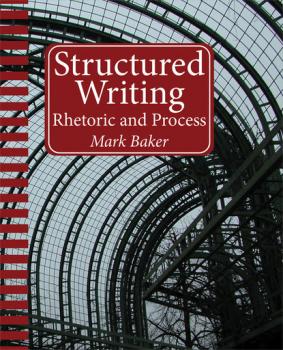Отраслевые издания
Различные книги в жанре Отраслевые изданияStructured Writing
Structured writing has never been more important or more confusing. We keep trying to do more and more with content, but we give ourselves less and less time to do it. Structured content can help keep your rhetoric on track and your processes efficient. But how does it do that and what is the relationship between rhetoric and process? It is easy to get lost in sea of acronyms and buzz words: semantics, XML, metadata, DITA, structure, DocBook, hypertext, Markdown, topics, XSLT, reuse, LaTeX, silos, HTML. Structured Writing cuts through the noise, explaining what structured writing is (you have been doing it all along) and how you can use different structures to achieve different purposes. It focuses on how you can partition and manage the complexity of the content creation process using structured writing techniques to ensure that everything is handled by the person or process with the skills, time, and resources to handle it effectively. Most importantly, this book shows you how the right structured writing techniques can improve the quality of your content and, at the same time, make your content processes more efficient without sacrificing quality for efficiency or vice versa. There are so many options available in the structured writing space today. This book will show you where each of them fits and help you choose the approach that is optimal for your content.
Cascading Style Sheets (Speedy Study Guides)
Here is a cheat sheet for some of the most basic codes for the novice programmers. Programming is like writing English sentences; except that you're trying to build a command function that would respond to prompts and triggers. This books offers an easier and more effective way of remembering basic programming codes. With this book, coding is made so much simpler. Grab a copy today.
Continuity With Change
"[Continuity with Change] seeks to document and demonstrate that middle positions between Change and Continuity are possible and desirable." – Canadian Architect "[Continuity with Change] is well produced with a large number of good photographs, maps, and drawings … obviously designed for a wide audience of planners and others active in heritage conservation." – The Journal of the Society for Industrial Archeology "[Continuity with Change] deserves a spot in the library of any professional who works regularly with older ubildings and their surroundings." – Plan Canada
Hyperbolic Metamaterials
Hyperbolic metamaterials were originally introduced to overcome the diffraction limit of optical imaging. Soon thereafter it was realized that hyperbolic metamaterials demonstrate a number of novel phenomena resulting from the broadband singular behavior of their density of photonic states. These novel phenomena and applications include super resolution imaging, new stealth technologies, enhanced quantum-electrodynamic effects, thermal hyperconductivity, superconductivity, and interesting gravitation theory analogs. Here I review typical material systems, which exhibit hyperbolic behavior and outline important new applications of hyperbolic metamaterials, such as imaging experiments with plasmonic hyperbolic metamaterials and novel VCSEL geometries, in which the Bragg mirrors may be engineered in such a way that they exhibit hyperbolic properties in the long wavelength infrared range, so that they may be used to efficiently remove excess heat from the laser cavity. I will also discuss potential applications of self-assembled photonic hypercrystals. This system bypasses 3D nanofabrication issues, which typically limit hyperbolic metamaterial applications. Photonic hypercrystals combine the most interesting features of hyperbolic metamaterials and photonic crystals.
Sterile Neutrino Dark Matter
This book is a new look at one of the hottest topics in contemporary science, Dark Matter. It is the pioneering text dedicated to sterile neutrinos as candidate particles for Dark Matter, challenging some of the standard assumptions which may be true for some Dark Matter candidates but not for all. So, this can be seen either as an introduction to a specialized topic or an out-of-the-box introduction to the field of Dark Matter in general. No matter if you are a theoretical particle physicist, an observational astronomer, or a ground based experimentalist, no matter if you are a grad student or an active researcher, you can benefit from this text, for a simple reason: a non-standard candidate for Dark Matter can teach you a lot about what we truly know about our standard picture of how the Universe works.
Information Architecture
Information Architecture is about organizing and simplifying information, designing and integrating information spaces/systems, and creating ways for people to find and interact with information content. Its goal is to help people understand and manage information and make the right decisions accordingly. This updated and revised edition of the book looks at integrated information spaces in the web context and beyond, with a focus on putting theories and principles into practice. In the ever-changing social, organizational, and technological contexts, information architects not only design individual information spaces (e.g., websites, software applications, and mobile devices), but also tackle strategic aggregation and integration of multiple information spaces across websites, channels, modalities, and platforms. Not only do they create predetermined navigation pathways, but they also provide tools and rules for people to organize information on their own and get connected with others. Information architects work with multi-disciplinary teams to determine the user experience strategy based on user needs and business goals, and make sure the strategy gets carried out by following the user-centered design (UCD) process via close collaboration with others. Drawing on the authors’ extensive experience as HCI researchers, User Experience Design practitioners, and Information Architecture instructors, this book provides a balanced view of the IA discipline by applying theories, design principles, and guidelines to IA and UX practices. It also covers advanced topics such as iterative design, UX decision support, and global and mobile IA considerations. Major revisions include moving away from a web-centric view toward multi-channel, multi-device experiences. Concepts such as responsive design, emerging design principles, and user-centered methods such as Agile, Lean UX, and Design Thinking are discussed and related to IA processes and practices.
Optical Nanomanipulation
This book provides a broad introductory survey of this remarkable field, aiming to establish and clearly differentiate its physical principles, and also to provide a snapshot portrait of many of the most prominent current applications. Primary emphasis is placed on developing an understanding of the fundamental photonic origin behind the mechanism that operates in each type of effect. To this end, the first few chapters introduce and develop core theory, focusing on the physical significance and source of the most salient parameters, and revealing the detailed interplay between the key material and optical properties. Where appropriate, both classical and photonic (quantum mechanical) representations are discussed. The number of equations is purposely kept to a minimum, and only a broad background in optical physics is assumed. With copious examples and illustrations, each of the subsequent chapters then sets out to explain and exhibit the main features and uses of the various distinct types of mechanism that can be involved in optical nanomanipulation, including some of the very latest developments. To complete the scene, we also briefly discuss applications to larger, biological particles. Overall, this book aims to deliver to the non-specialist an amenable introduction to the technically more advanced literature on individual manipulation methods. Full references to the original research papers are given throughout, and an up-to-date bibliography is provided for each chapter, which directs the reader to other selected, more specialised sources.
Sound-Power Flow
Sound-Power Flow: A practitioner's handbook for sound intensity is a guide for practitioners and research scientists in different areas of acoustical science. There are three fundamental quantities in acoustics: sound pressure, sound particle velocity, and sound intensity. This book is about sound intensity and demonstrates the advantages and uses of acoustical sensing compared with other forms of sensing. It describes applications such as: measuring total sound power; directional hearing of humans and mammals; echolocation; measuring sound-power flow in ducts; and uses of non-contact, focused, high-frequency, pulse-echo ultrasonic probes. This book presents computational approaches using standard mathematics, and relates these to the measurement of sound-power flow in air and water. It also uses linear units rather than logarithmic units – this making computation in acoustics simpler and more accessible to advanced mathematics and computing. The book is based on work by the author and his associates at General Motors, the University of Mississippi, and Sonometrics.
A Guided Tour of Light Beams
From science fiction death rays to supermarket scanners, lasers have become deeply embedded in our daily lives and our culture. But in recent decades the standard laser beam has evolved into an array of more specialized light beams with a variety of strange and counterintuitive properties. Some of them have the ability to reconstruct themselves after disruption by an obstacle, while others can bend in complicated shapes or rotate like a corkscrew. These unusual optical effects open new and exciting possibilities for science and technology. For example, they make possible microscopic tractor beams that pull objects toward the source of the light, and they allow the trapping and manipulation of individual molecules to construct specially-tailored nanostructures for engineering or medical use. It has even been found that beams of light can produce lines of darkness that can be tied in knots. This book is an introductory survey of these specialized light beams and their scientific applications, at a level suitable for undergraduates with a basic knowledge of optics and quantum mechanics. It provides a unified treatment of the subject, collecting together in textbook form for the first time many topics currently found only in the original research literature.
Quantifying Measurement
Measurements and experiments are made each and every day, in fields as disparate as particle physics, chemistry, economics and medicine, but have you ever wondered why it is that a particular experiment has been designed to be the way it is. Indeed, how do you design an experiment to measure something whose value is unknown, and what should your considerations be on deciding whether an experiment has yielded the sought after, or indeed any useful result? These are old questions, and they are the reason behind this volume. We will explore the origins of the methods of data analysis that are today routinely applied to all measurements, but which were unknown before the mid-19th Century. Anyone who is interested in the relationship between the precision and accuracy of measurements will find this volume useful. Whether you are a physicist, a chemist, a social scientist, or a student studying one of these subjects, you will discover that the basis of measurement is the struggle to identify the needle of useful data hidden in the haystack of obscuring background noise.









